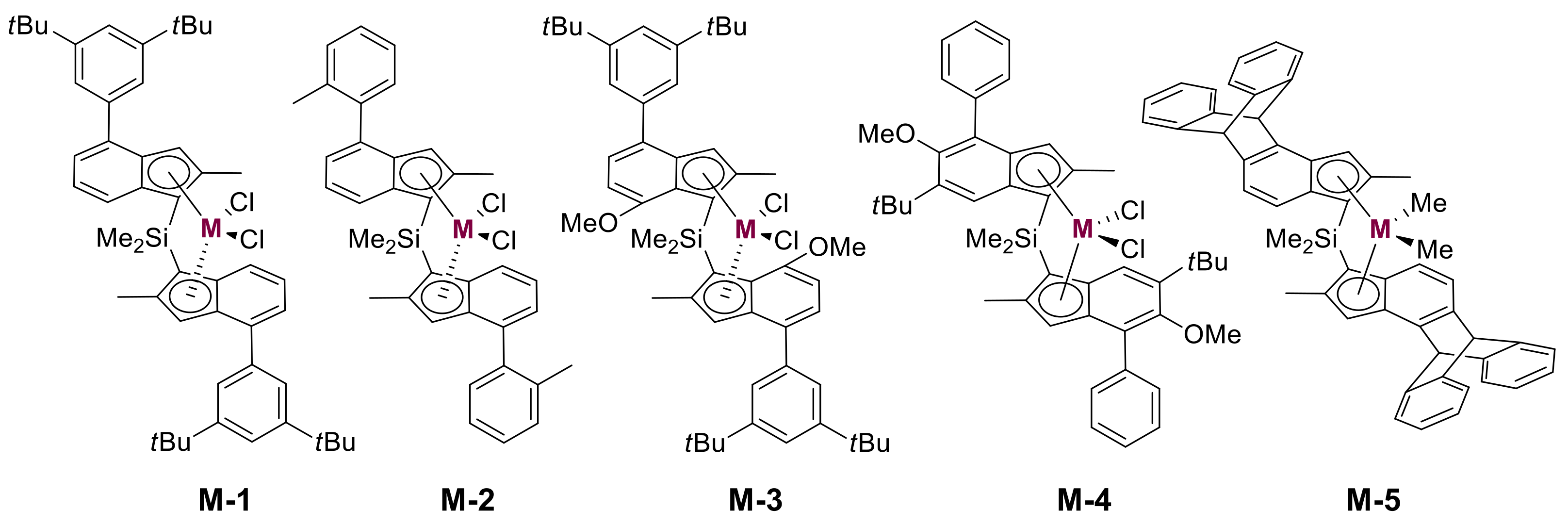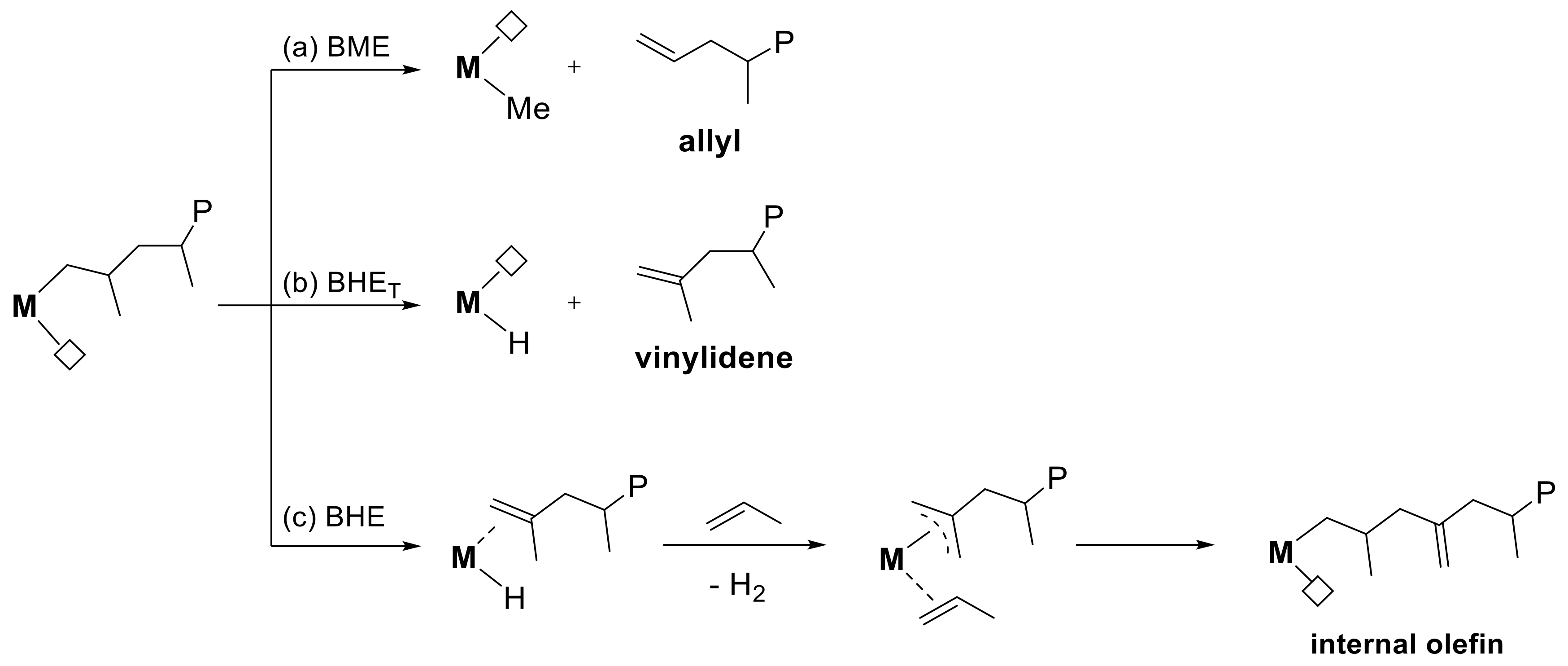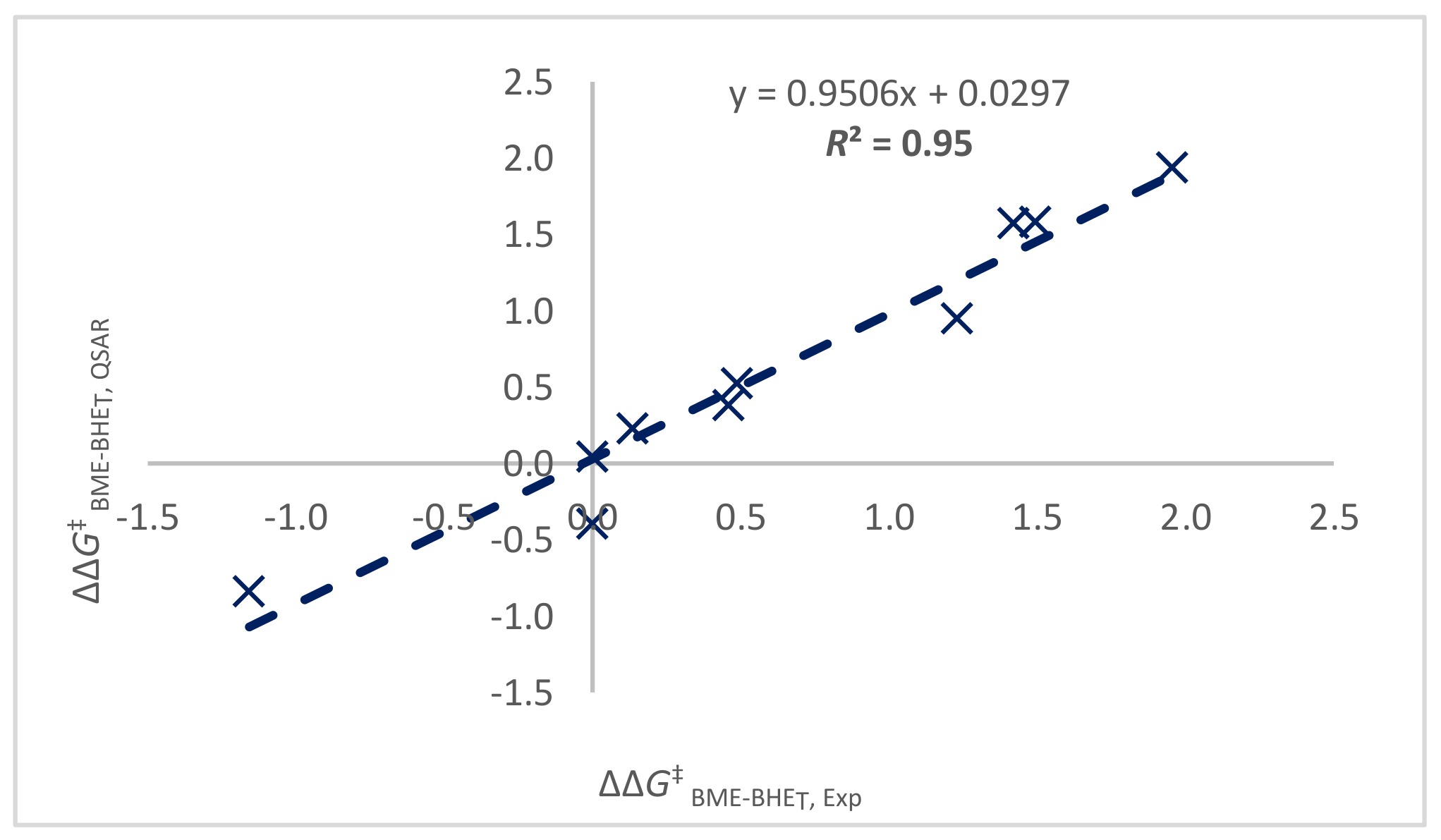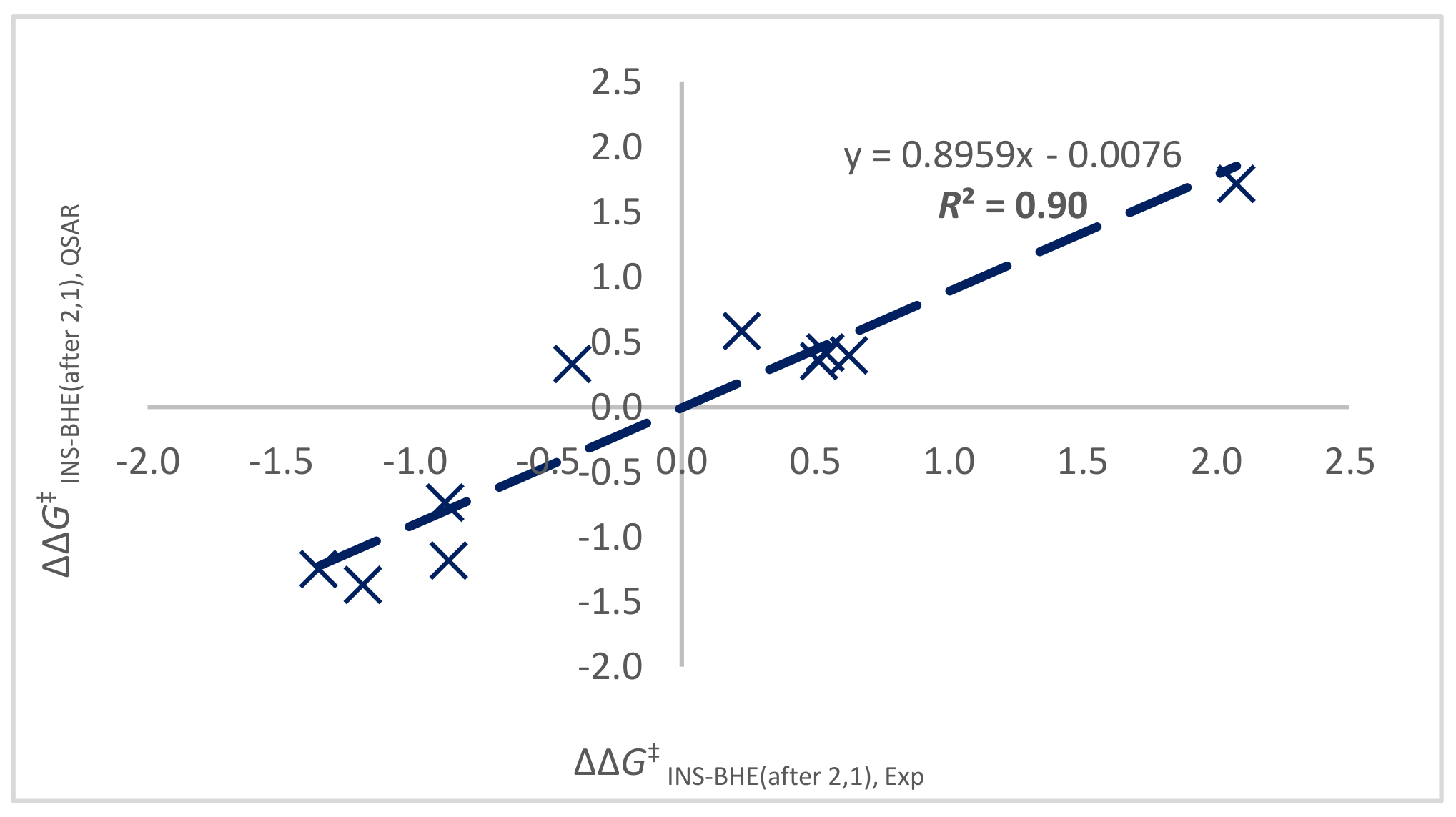Hafnium vs. Zirconium, the Perpetual Battle for Supremacy in Catalytic Olefin Polymerization: A Simple Matter of Electrophilicity?
Abstract
:1. Introduction
2. Materials and Methods
2.1. Catalyst Synthesis
2.2. Polymer Synthesis and Characterization
2.3. Computational Details
2.3.1. Precursor Structures for QSAR Models
2.3.2. PES Calculations for Catalyst Pair M-2
3. Results and Discussion
3.1. Polymerization Screening
3.2. Differences between Hf and Zr
3.2.1. Can Zirconocene QSAR Models Be Easily Extended to Hf?
3.2.2. Modeling Key Differences between Hf/Zr
3.2.3. Rationalizing the “Hafnium Effect”
4. Conclusions
Supplementary Materials
Author Contributions
Funding
Institutional Review Board Statement
Informed Consent Statement
Data Availability Statement
Acknowledgments
Conflicts of Interest
References
- McDaniel, M.P. Chapter 3—A Review of the Phillips Supported Chromium Catalyst and Its Commercial Use for Ethylene Polymerization; Gates, B.C., Knözinger, H.B.T., Eds.; Academic Press: Cambridge, MA, USA, 2010; Volume 53, pp. 123–606. [Google Scholar]
- Pasquini, N. Polypropylene Handbook, 2nd ed.; Hanser Publishers: Munich, Germany, 2005. [Google Scholar]
- Baier, M.C.; Zuideveld, M.A.; Mecking, S. Post-metallocenes in the industrial production of polyolefins. Angew. Chem. Int. Ed. 2014, 53, 9722–9744. [Google Scholar] [CrossRef] [PubMed]
- Klosin, J.; Fontaine, P.P.; Figueroa, R. Development of group IV molecular catalysts for high temperature ethylene-α-olefin copolymerization reactions. Acc. Chem. Res. 2015, 48, 2004–2016. [Google Scholar] [CrossRef] [PubMed]
- Stürzel, M.; Mihan, S.; Mülhaupt, R. From Multisite Polymerization Catalysis to Sustainable Materials and All-Polyolefin Composites. Chem. Rev. 2016, 116, 1398–1433. [Google Scholar] [CrossRef]
- Machat, M.R.; Jandl, C.; Rieger, B. Titanocenes in olefin polymerization: Sustainable catalyst system or an extinct species? Organometallics 2017, 36, 1408–1418. [Google Scholar] [CrossRef]
- Lee, M.H.; Han, Y.; Kim, D.; Hwang, J.-W.; Do, Y. Isospecific Propylene Polymerization by C1-Symmetric Me2Si(C5Me4)(2-R-Ind)MCl2 (M = Ti, Zr) Complexes. Organometallics 2003, 22, 2790–2796. [Google Scholar] [CrossRef]
- Mallin, D.T.; Rausch, M.D.; Lin, Y.G.; Dong, S.; Chien, J.C.W. rac-[Ethylidene(1-eta.5-tetramethylcyclopentadienyl)(1-eta.5-indenyl)]dichlorotitanium and its homopolymerization of propylene to crystalline-amorphous block thermoplastic elastomers. J. Am. Chem. Soc. 1990, 112, 2030–2031. [Google Scholar] [CrossRef]
- Shannon, R.D.; Prewitt, C.T. Effective ionic radii in oxides and fluorides. Acta Crystallogr. Sect. B Struct. Crystallogr. Cryst. Chem. 1969, 25, 925–946. [Google Scholar] [CrossRef]
- Shannon, R.D. Revised effective ionic radii and systematic studies of interatomic distances in halides and chalcogenides. Acta Crystallogr. Sect. A 1976, 32, 751–767. [Google Scholar] [CrossRef]
- Resconi, L.; Cavallo, L.; Fait, A.; Piemontesi, F. Selectivity in propene polymerization with metallocene catalysts. Chem. Rev. 2000, 100, 1253–1345. [Google Scholar] [CrossRef]
- Kaminsky, W. Production of Polyolefins by Metallocene Catalysts and Their Recycling by Pyrolysis. Macromol. Symp. 2016, 360, 10–22. [Google Scholar] [CrossRef]
- Busico, V.; Cipullo, R.; Pellecchia, R.; Talarico, G.; Razavi, A. Hafnocenes and MAO: Beware of trimethylaluminum! Macromolecules 2009, 42, 1789–1791. [Google Scholar] [CrossRef]
- Razavi, A.; Peters, L.; Nafpliotis, L. Geometric flexibility, ligand and transition metal electronic effects on stereoselective polymerization of propylene in homogeneous catalysis. J. Mol. Catal. A Chem. 1997, 115, 129–154. [Google Scholar] [CrossRef]
- Machat, M.R.; Fischer, A.; Schmitz, D.; Vöst, M.; Drees, M.; Jandl, C.; Pöthig, A.; Casati, N.P.M.; Scherer, W.; Rieger, B. Behind the Scenes of Group 4 Metallocene Catalysis: Examination of the Metal-Carbon Bond. Organometallics 2018, 37, 2690–2705. [Google Scholar] [CrossRef]
- Cuthbert, E.N.T.; Vittoria, A.; Cipullo, R.; Busico, V.; Budzelaar, P.H.M. Structure-Activity Relationships for Bis(phenolate-ether) Zr/Hf Propene Polymerization Catalysts. Eur. J. Inorg. Chem. 2020, 2020, 541–550. [Google Scholar] [CrossRef]
- Goryunov, G.P.; Sharikov, M.I.; Iashin, A.N.; Canich, J.A.M.; Mattler, S.J.; Hagadorn, J.R.; Uborsky, D.V.; Voskoboynikov, A.Z. Rigid Postmetallocene Catalysts for Propylene Polymerization: Ligand Design Prevents the Temperature-Dependent Loss of Stereo-and Regioselectivities. ACS Catal. 2021, 11, 8079–8086. [Google Scholar] [CrossRef]
- Schöbel, A.; Herdtweck, E.; Parkinson, M.; Rieger, B. Ultra-rigid metallocenes for highly iso- and regiospecific polymerization of propene: The search for the perfect polypropylene helix. Chem. A Eur. J. 2012, 18, 4174–4178. [Google Scholar] [CrossRef]
- Reichelt, K.; Parkinson, M.; Resconi, L. Influence of Temperature on the Regioselectivity of Highly Isospecific C2-Symmetric Zirconocenes in Propene Polymerization. Macromol. Chem. Phys. 2016, 217, 2415–2430. [Google Scholar] [CrossRef]
- Nifant’ev, I.E.; Ivchenko, P.V.; Bagrov, V.V.; Churakov, A.V.; Mercandelli, P. 5-Methoxy-substituted zirconium bis-indenyl ansa -complexes: Synthesis, structure, and catalytic activity in the polymerization and copolymerization of alkenes. Organometallics 2012, 31, 4962–4970. [Google Scholar] [CrossRef]
- Izmer, V.V.; Lebedev, A.Y.; Kononovich, D.S.; Borisov, I.S.; Kulyabin, P.S.; Goryunov, G.P.; Uborsky, D.V.; Canich, J.A.M.; Voskoboynikov, A.Z. ansa-Metallocenes Bearing 4-(N-Azolyl)-2-methylindenyl and Related Ligands: Development of Highly Isoselective Catalysts for Propene Polymerization at Higher Temperatures. Organometallics 2019, 38, 4645–4657. [Google Scholar] [CrossRef]
- Resconi, L.; Virkkunen, V.; Noureddine, A.; Castro, P.; Izmer, V.; Kononovich, D.; Voskoboynikov, A. Catalyst. WO 2014096282A1, 26 June 2014. [Google Scholar]
- Ehm, C.; Vittoria, A.; Goryunov, G.P.; Kulyabin, P.S.; Budzelaar, P.H.M.; Voskoboynikov, A.Z.; Busico, V.; Uborsky, D.V.; Cipullo, R. Connection of Stereoselectivity, Regioselectivity, and Molecular Weight Capability in rac-R′2Si(2-Me-4-R-indenyl)2ZrCl2 Type Catalysts. Macromolecules 2018, 51, 8073–8083. [Google Scholar] [CrossRef]
- Kulyabin, P.S.; Goryunov, G.P.; Sharikov, M.I.; Izmer, V.V.; Vittoria, A.; Budzelaar, P.H.M.; Busico, V.; Voskoboynikov, A.Z.; Ehm, C.; Cipullo, R.; et al. ansa-Zirconocene Catalysts for Isotactic-Selective Propene Polymerization at High Temperature: A Long Story Finds a Happy Ending. J. Am. Chem. Soc. 2021, 143, 7641–7647. [Google Scholar] [CrossRef] [PubMed]
- Ehm, C.; Vittoria, A.; Goryunov, G.P.; Izmer, V.V.; Kononovich, D.S.; Samsonov, O.V.; Girolamo, R.D.; Budzelaar, P.H.M.; Voskoboynikov, A.Z.; Busico, V.; et al. An integrated high throughput experimentation/predictive QSAR modeling approach to ansa-zirconocene catalysts for isotactic polypropylene. Polymers 2020, 12, 1005. [Google Scholar] [CrossRef]
- Busico, V.; Cipullo, R.; Mingione, A.; Rongo, L. Accelerating the Research Approach to Ziegler-Natta Catalysts. Ind. Eng. Chem. Res. 2016, 55, 2686–2695. [Google Scholar] [CrossRef]
- Busico, V.; Pellecchia, R.; Cutillo, F.; Cipullo, R. High-throughput screening in olefinpolymerization catalysis: From serendipitous discovery towards rational understanding. Macromol. Rapid Commun. 2009, 30, 1697–1708. [Google Scholar] [CrossRef] [PubMed]
- Vittoria, A.; Meppelder, A.; Friederichs, N.; Busico, V.; Cipullo, R. Demystifying Ziegler-Natta Catalysts: The Origin of Stereoselectivity. ACS Catal. 2017, 7, 4509–4518. [Google Scholar] [CrossRef]
- Vittoria, A.; Busico, V.; Cannavacciuolo, F.D.; Cipullo, R. Molecular Kinetic Study of “chain Shuttling” Olefin Copolymerization. ACS Catal. 2018, 8, 5051–5061. [Google Scholar] [CrossRef]
- Vittoria, A.; Mingione, A.; Abbate, R.A.; Cipullo, R.; Busico, V. High Throughput Experimentation Protocol for Quantitative Measurements of Regioselectivity in Ziegler-Natta Polypropylene Catalysis. Ind. Eng. Chem. Res. 2019, 58, 14729–14735. [Google Scholar] [CrossRef]
- Uborsky, D.V.; Mladentsev, D.Y.; Guzeev, B.A.; Borisov, I.S.; Vittoria, A.; Ehm, C.; Cipullo, R.; Hendriksen, C.; Friederichs, N.; Busico, V.; et al. C 1-Symmetric Si-bridged (2-indenyl)(1-indenyl) ansa -metallocenes as efficient ethene/1-hexene copolymerization catalysts. Dalt. Trans. 2020, 49, 3015–3025. [Google Scholar] [CrossRef]
- Ehm, C.; Vittoria, A.; Goryunov, G.P.; Izmer, V.V.; Kononovich, D.S.; Kulyabin, P.S.; Di Girolamo, R.; Budzelaar, P.H.M.; Voskoboynikov, A.Z.; Busico, V.; et al. A Systematic Study of the Temperature-Induced Performance Decline of ansa-Metallocenes for iPP. Macromolecules 2020, 53, 9325–9336. [Google Scholar] [CrossRef]
- Ehm, C.; Vittoria, A.; Goryunov, G.P.; Izmer, V.V.; Kononovich, D.S.; Samsonov, O.V.; Budzelaar, P.H.M.; Voskoboynikov, A.Z.; Busico, V.; Uborsky, D.V.; et al. On the limits of tuning comonomer affinity of ‘Spaleck-type’ ansa-zirconocenes in ethene/1-hexene copolymerization: A high-throughput experimentation/QSAR approach. Dalt. Trans. 2020, 49, 10162–10172. [Google Scholar] [CrossRef]
- Ehm, C.; Budzelaar, P.H.M.; Busico, V. Calculating accurate barriers for olefin insertion and related reactions. J. Organomet. Chem. 2015, 775, 39–49. [Google Scholar] [CrossRef]
- Frisch, M.J.; Trucks, G.W.; Schlegel, H.B.; Scuseria, G.E.; Robb, M.A.; Cheeseman, J.R.; Scalmani, G.; Barone, V.; Petersson, G.A.; Nakatsuji, H.; et al. Gaussian 16, Revision A.1; Gaussian, Inc.: Wallingford, CT, USA, 2016. [Google Scholar]
- Baker, J. An algorithm for the location of transition states. J. Comput. Chem. 1986, 7, 385–395. [Google Scholar] [CrossRef]
- Baker, J. PQS, Version 2.4; Parallel Quantum Solutions: Fayetteville, AR, USA, 2001. [Google Scholar]
- Budzelaar, P.H.M. Geometry optimization using generalized, chemically meaningful constraints. J. Comput. Chem. 2007, 28, 2226–2236. [Google Scholar] [CrossRef]
- Tao, J.; Perdew, J.P.; Staroverov, V.N.; Scuseria, G.E. Climbing the density functional ladder: Nonempirical meta–generalized gradient approximation designed for molecules and solids. Phys. Rev. Lett. 2003, 91, 146401. [Google Scholar] [CrossRef] [Green Version]
- Balabanov, N.B.; Peterson, K.A. Systematically convergent basis sets for transition metals. I. All-electron correlation consistent basis sets for the 3d elements Sc-Zn. J. Chem. Phys. 2005, 123, 64107. [Google Scholar] [CrossRef] [Green Version]
- Balabanov, N.B.; Peterson, K.A. Basis set limit electronic excitation energies, ionization potentials, and electron affinities for the 3d transition metal atoms: Coupled cluster and multireference methods. J. Chem. Phys. 2006, 125, 74110. [Google Scholar] [CrossRef] [PubMed] [Green Version]
- Schuchardt, K.L.; Didier, B.T.; Elsethagen, T.; Sun, L.; Gurumoorthi, V.; Chase, J.; Li, J.; Windus, T.L. Basis set exchange: A community database for computational sciences. J. Chem. Inf. Modeling 2007, 47, 1045–1052. [Google Scholar] [CrossRef] [Green Version]
- Peterson, K.A.; Figgen, D.; Dolg, M.; Stoll, H. Energy-consistent relativistic pseudopotentials and correlation consistent basis sets for the 4d elements Y–Pd. J. Chem. Phys. 2007, 126, 124101. [Google Scholar] [CrossRef] [PubMed]
- Schwerdtfeger, P. The Pseudopotential Approximation in Electronic Structure Theory. Chem. Phys. Chem. 2011, 12, 3143–3155. [Google Scholar] [CrossRef]
- Zhao, Y.; Truhlar, D.G. The M06 suite of density functionals for main group thermochemistry, thermochemical kinetics, noncovalent interactions, excited states, and transition elements: Two new functionals and systematic testing of four M06-class functionals and 12 other function. Theor. Chem. Acc. 2008, 120, 215–241. [Google Scholar] [CrossRef] [Green Version]
- Ehm, C.; Cipullo, R.; Budzelaar, P.H.M.; Busico, V. Role(s) of TMA in polymerization. Dalt. Trans. 2016, 45, 6847–6855. [Google Scholar] [CrossRef]
- Zaccaria, F.; Ehm, C.; Budzelaar, P.H.M.; Busico, V. Accurate prediction of copolymerization statistics in molecular olefin polymerization catalysis: The role of entropic, electronic, and steric effects in catalyst comonomer affinity. ACS Catal. 2017, 7, 1512–1519. [Google Scholar] [CrossRef]
- Zaccaria, F.; Cipullo, R.; Budzelaar, P.H.M.; Busico, V.; Ehm, C. Backbone rearrangement during olefin capture as the rate limiting step in molecular olefin polymerization catalysis and its effect on comonomer affinity. J. Polym. Sci. Part A Polym. Chem. 2017, 55, 2807–2814. [Google Scholar] [CrossRef]
- Zaccaria, F.; Cipullo, R.; Correa, A.; Budzelaar, P.H.M.P.H.M.; Busico, V.; Ehm, C. Separating electronic from steric effects in Ethene/α-Olefin copolymerization: A case study on Octahedral [ONNO] Zr-Catalysts. Processes 2019, 7, 384. [Google Scholar] [CrossRef] [Green Version]
- Ehm, C.; Cipullo, R.; Passaro, M.; Zaccaria, F.; Budzelaar, P.H.M.; Busico, V. Chain transfer to solvent in propene polymerization with Ti Cp-phosphinimide catalysts: Evidence for chain termination via Ti-C bond homolysis. ACS Catal. 2016, 6, 7989–7993. [Google Scholar] [CrossRef]
- Zaccaria, F.; Ehm, C.; Budzelaar, P.H.M.; Busico, V.; Cipullo, R. Catalyst Mileage in Olefin Polymerization: The Peculiar Role of Toluene. Organometallics 2018, 37, 2872–2879. [Google Scholar] [CrossRef]
- Zaccaria, F.; Zuccaccia, C.; Cipullo, R.; Budzelaar, P.H.M.; Macchioni, A.; Busico, V.; Ehm, C. Toluene and α-Olefins as Radical Scavengers: Direct NMR Evidence for Homolytic Chain Transfer Mechanism Leading to Benzyl and “dormant” Titanium Allyl Complexes. Organometallics 2018, 37, 4189–4194. [Google Scholar] [CrossRef]
- Ehm, C.; Budzelaar, P.H.M.; Busico, V. Metal–carbon bond strengths under polymerization conditions: 2,1-insertion as a catalyst stress test. J. Catal. 2017, 351, 146–152. [Google Scholar] [CrossRef]
- Ehm, C.; Budzelaar, P.H.M.; Busico, V. Tuning the Relative Energies of Propagation and Chain Termination Barriers in Polyolefin Catalysis through Electronic and Steric Effects. Eur. J. Inorg. Chem. 2017, 2017, 3343–3349. [Google Scholar] [CrossRef]
- Baerends, E.J.; Ellis, D.E.; Ros, P. Self-consistent molecular Hartree-Fock-Slater calculations I. The computational procedure. Chem. Phys. 1973, 2, 41–51. [Google Scholar] [CrossRef]
- Whitten, J.L. Coulombic potential energy integrals and approximations. J. Chem. Phys. 1973, 58, 4496–4501. [Google Scholar] [CrossRef]
- Feyereisen, M.; Fitzgerald, G.; Komornicki, A. Use of approximate integrals in ab initio theory. An application in MP2 energy calculations. Chem. Phys. Lett. 1993, 208, 359–363. [Google Scholar] [CrossRef]
- Vahtras, O.; Almlöf, J.; Feyereisen, M.W. Integral approximations for LCAO-SCF calculations. Chem. Phys. Lett. 1993, 213, 514–518. [Google Scholar] [CrossRef]
- Falivene, L.; Credendino, R.; Poater, A.; Petta, A.; Serra, L.; Oliva, R.; Scarano, V.; Cavallo, L. SambVca 2. A Web Tool for Analyzing Catalytic Pockets with Topographic Steric Maps. Organometallics 2016, 35, 2286–2293. [Google Scholar] [CrossRef] [Green Version]
- Glendening, E.D.; Reed, A.E.; Carpenter, J.E.; Weinhold, F. NBO Version 3.1; University of Wisconsin: Madison, WI, USA, 1998. [Google Scholar]
- Yu, H.S.; He, X.; Li, S.L.; Truhlar, D.G. MN15: A Kohn–Sham global-hybrid exchange–correlation density functional with broad accuracy for multi-reference and single-reference systems and noncovalent interactions. Chem. Sci. 2016, 7, 5032–5051. [Google Scholar] [CrossRef] [PubMed] [Green Version]
- Marenich, A.V.; Cramer, C.J.; Truhlar, D.G. Universal Solvation Model Based on Solute Electron Density and on a Continuum Model of the Solvent Defined by the Bulk Dielectric Constant and Atomic Surface Tensions. J. Phys. Chem. B 2009, 113, 6378–6396. [Google Scholar] [CrossRef] [PubMed]
- Busico, V.; Cipullo, R. Microstructure of polypropylene. Prog. Polym. Sci. 2001, 26, 443–533. [Google Scholar] [CrossRef]
- Resconi, L.; Camurati, I.; Sudmeijer, O. Chain transfer reactions in propylene polymerization with zirconocene catalysts. Top. Catal. 1999, 7, 145–163. [Google Scholar] [CrossRef]
- Stapleton, R.A.; Al-Humydi, A.; Chai, J.; Galan, B.R.; Collins, S. Sterically hindered aluminum alky is: Weakly interacting scavenging agents of use in olefin polymerization. Organometallics 2006, 25, 5083–5092. [Google Scholar] [CrossRef]
- Zaccaria, F.; Zuccaccia, C.; Cipullo, R.; Budzelaar, P.H.M.P.H.M.; Macchioni, A.; Busico, V.; Ehm, C. BHT-Modified MAO: Cage Size Estimation, Chemical Counting of Strongly Acidic Al Sites, and Activation of a Ti-Phosphinimide Precatalyst. ACS Catal. 2019, 9, 2996–3010. [Google Scholar] [CrossRef]
- Zaccaria, F.; Zuccaccia, C.; Cipullo, R.; Budzelaar, P.H.M.; Macchioni, A.; Busico, V.; Ehm, C. On the Nature of the Lewis Acidic Sites in “TMA-Free” Phenol-Modified Methylaluminoxane. Eur. J. Inorg. Chem. 2020, 2020, 1088–1095. [Google Scholar] [CrossRef]
- Cherkasov, A.; Muratov, E.N.; Fourches, D.; Varnek, A.; Baskin, I.I.; Cronin, M.; Dearden, J.; Gramatica, P.; Martin, Y.C.; Todeschini, R.; et al. QSAR modeling: Where have you been? Where are you going to? J. Med. Chem. 2014, 57, 4977–5010. [Google Scholar] [PubMed] [Green Version]
- Talarico, G.; Budzelaar, P.H.M. Variability of chain transfer to monomer step in olefin polymerization. Organometallics 2008, 27, 4098–4107. [Google Scholar] [CrossRef]
- Simões, J.A.M.; Beauchamp, J.L. Transition Metal–Hydrogen and Metal–Carbon Bond Strengths: The Keys to Catalysis. Chem. Rev. 1990, 90, 629–688. [Google Scholar] [CrossRef]
- Ehm, C.; Zaccaria, F.; Cipullo, R. From Mechanistic Investigation to Quantitative Prediction: Kinetics of Homogeneous Transition Metal-Catalyzed α-Olefin Polymerization Predicted by Computational Chemistry. In Computational Quantum Chemistry; Soroush, M., Ed.; Elsevier: Amsterdam, The Netherlands, 2019; pp. 287–326. [Google Scholar]
- Hammond, G.S. A Correlation of Reaction Rates. J. Am. Chem. Soc. 1955, 77, 334–338. [Google Scholar] [CrossRef]
- Laine, A.; Linnolahti, M.; Pakkanen, T.A.; Severn, J.R.; Kokko, E.; Pakkanen, A. Comparative Theoretical Study on Homopolymerization of α-Olefins by Bis(cyclopentadienyl) Zirconocene and Hafnocene: Elemental Propagation and Termination Reactions between Monomers and Metals. Organometallics 2010, 29, 1541–1550. [Google Scholar] [CrossRef]






| 60 °C | 100 °C | |||||||||||||
|---|---|---|---|---|---|---|---|---|---|---|---|---|---|---|
| ID | 2,1 % | 3,1 % | regiotot# % | 1-σ ≠ % | Mn KDa | Mw/Mn | Tm °C | 2,1 % | 3,1 % | regiotot# % | 1-σ ≠ % | Mn KDa | Mw/Mn | Tm °C |
| Zr-1 † | 0.17 | n.d. | 0.17 | 0.06 | 530 | 2.2 | 162.4 | 0.21 | 0.09 | 0.30 | 0.18 | 60 | 2.0 | 153.9 |
| Hf-1 | 0.06 | 0.02 | 0.08 | 0.14 | 390 | 2.1 | 162.6 | 0.02 | 0.10 | 0.12 | 0.67 | 31 | 2.0 | 151.9 |
| Zr-2† | 0.32 | 0.09 | 0.42 | 0.02 | 470 | 1.8 | 158.2 | 0.19 | 0.33 | 0.52 | 0.19 | 48 | 1.9 | 152.2 |
| Hf-2 | 0.15 | 0.09 | 0.24 | 0.10 | 210 | 2.4 | 158.8 | 0.04 | 0.25 | 0.28 | 0.75(6) | 16 | 2.0 | 149.1 |
| Zr-3† | 0.23 | n.d. | 0.23 | 0.03 | 400 | 2.2 | 162.2 | 0.29 | 0.14 | 0.43 | 0.10 | 44 | 2.0 | 154.6 |
| Hf-3 | 0.07 | n.d. | 0.07 | 0.17 | 1500 | 2.2 | 165.5 | 0.04 | 0.13 | 0.17 | 0.30 | 60 | 2.0 | 156.0 |
| Zr-4† | 0.67 | 0.04 | 0.71 | 0.02 | 1400 | 2.3 | 156.0 | 0.57 | 0.42 | 0.99 | 0.06 | 160 | 2.2 | 149.5 |
| Hf-4 | 0.38(3) | 0.12 | 0.50(4) | 0.07 | 1900 | 2.2 | 156.1 | 0.13 | 0.42 | 0.56(3) | 0.21 | 140 | 2.0 | 151.6 |
| Zr-5† | 0.26 | n.d. | 0.26 | ≤0.02 | (1100) = | 2.5 | 163.2 | 0.33 | 0.02 | 0.35 | 0.03 | 200 | 2.1 | 157.4 |
| Hf-5 | 0.11 | n.d. | 0.11 | 0.03 | 1400 | 2.3 | 164.2 | 0.12 | 0.06 | 0.18 | 0.10 | 90 | 2.0 | 158.7 |
| ID | Δ%VBur * | q−MCl2† | Vinylidene, % | Internal Olefin, % | Allyl, % | xAllyl# |
|---|---|---|---|---|---|---|
| Zr-1 | 16.8 | 0.408 | 0.220 | 0.113 | 0.220 | 0.50 |
| Hf-1 | 16.9 | 0.414 | 0.020 | 0.030 | 0.105 | 0.84 |
| Zr-2 | 17.6 | 0.414 | 0.050 | 0.072 | 0.060 | 0.55 |
| Hf-2 | 17.9 | 0.421 | 0.032 | 0.042 | 0.240 | 0.88 |
| Zr-3 | 16.2 | 0.397 | 0.062 | 0.043 | 0.013 | 0.17 |
| Hf-3 | 16.5 | 0.405 | 0.042 | 0.025 | 0.081 | 0.66 |
| Zr-4 | 17.6 | 0.400 | 0.007 | 0.022 | 0.007 | 0.50 |
| Hf-4 | 18.4 | 0.406 | 0.005 | 0.014 | 0.034 | 0.87 |
| Zr-5 | 19.2 | 0.396 | 0.007 | 0.027 | 0.013 | 0.65 |
| Hf-5 | 20.0 | 0.400 | 0.003 | 0.032 | 0.042 | 0.93 |
Publisher’s Note: MDPI stays neutral with regard to jurisdictional claims in published maps and institutional affiliations. |
© 2021 by the authors. Licensee MDPI, Basel, Switzerland. This article is an open access article distributed under the terms and conditions of the Creative Commons Attribution (CC BY) license (https://creativecommons.org/licenses/by/4.0/).
Share and Cite
Vittoria, A.; Goryunov, G.P.; Izmer, V.V.; Kononovich, D.S.; Samsonov, O.V.; Zaccaria, F.; Urciuoli, G.; Budzelaar, P.H.M.; Busico, V.; Voskoboynikov, A.Z.; et al. Hafnium vs. Zirconium, the Perpetual Battle for Supremacy in Catalytic Olefin Polymerization: A Simple Matter of Electrophilicity? Polymers 2021, 13, 2621. https://doi.org/10.3390/polym13162621
Vittoria A, Goryunov GP, Izmer VV, Kononovich DS, Samsonov OV, Zaccaria F, Urciuoli G, Budzelaar PHM, Busico V, Voskoboynikov AZ, et al. Hafnium vs. Zirconium, the Perpetual Battle for Supremacy in Catalytic Olefin Polymerization: A Simple Matter of Electrophilicity? Polymers. 2021; 13(16):2621. https://doi.org/10.3390/polym13162621
Chicago/Turabian StyleVittoria, Antonio, Georgy P. Goryunov, Vyatcheslav V. Izmer, Dmitry S. Kononovich, Oleg V. Samsonov, Francesco Zaccaria, Gaia Urciuoli, Peter H. M. Budzelaar, Vincenzo Busico, Alexander Z. Voskoboynikov, and et al. 2021. "Hafnium vs. Zirconium, the Perpetual Battle for Supremacy in Catalytic Olefin Polymerization: A Simple Matter of Electrophilicity?" Polymers 13, no. 16: 2621. https://doi.org/10.3390/polym13162621
APA StyleVittoria, A., Goryunov, G. P., Izmer, V. V., Kononovich, D. S., Samsonov, O. V., Zaccaria, F., Urciuoli, G., Budzelaar, P. H. M., Busico, V., Voskoboynikov, A. Z., Uborsky, D. V., Ehm, C., & Cipullo, R. (2021). Hafnium vs. Zirconium, the Perpetual Battle for Supremacy in Catalytic Olefin Polymerization: A Simple Matter of Electrophilicity? Polymers, 13(16), 2621. https://doi.org/10.3390/polym13162621










